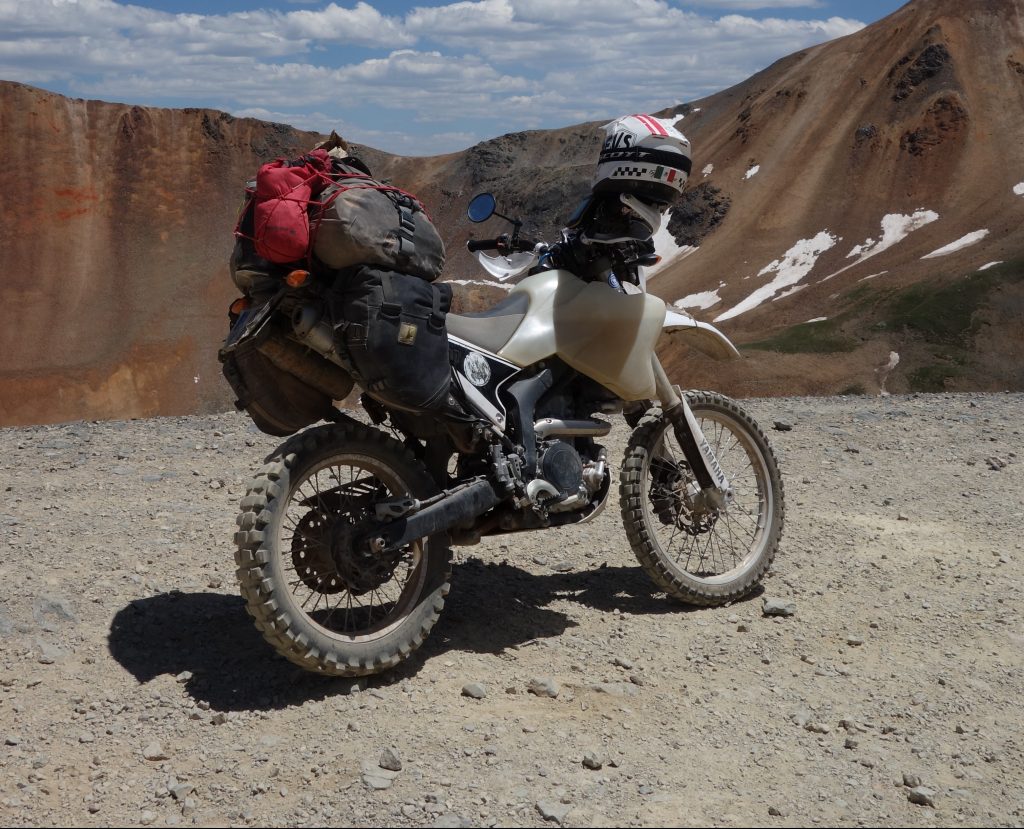Yamaha WR 250 R
(for english scroll down)
Die Daten:
Motor Einzylinder-Viertakt
Hubraum 250 cm³
Kraftübertragung Sechsganggetriebe/Kette
Leistung 22,6 kW (31 PS) bei 10 000/min
Max. Drehmoment 24 Nm bei 8000/min
Bremse vorn Scheibe (Ø 250 mm)
Bremse hinten Scheibe (Ø 230 mm)
Reifen vorn 80/100 R 21
Reifen hinten 120/80 R 18
Federweg vorn/hinten 270/270 mm
Tankinhalt 7,6 Liter, Normal
Gewicht vollgetankt 136 kg
Zuladung 185 kg
Verbrauch Landstraße 3,4 l/100 km
Ölwechsel alle 5000km, Ventilspielkontrolle bei 40000km !
Kleine Veränderungen habe ich natürlich vornehmen lassen:
17,8 Liter IMS Tank, bringt knappe 500km Reichweite
Ricochet Skit Plate (Motorschutz)
DRC 161 Offroad Spiegel, klappbar
DRC Wide Fußrasten (low ausführung, 5mm tiefer)
OSCO Kettenöler – die manuelle Lösung. Der ölt wenn ich es will und versaut nicht dauernd die Kette und alles rundherum (hat meinen Kettensatz auch 30000km am Leben erhalten).
Zusatzscheinwerfer LED – Billigteil von Amazon, hat wunderbare Dienste geleistet und ist erst nach ca 20000km abvibriert. Leuchten tut er nach wie vor…
Werkzeugröhre von AdventureSpecs
Der beste aller Captains hat das alles montiert und mir zusätzlich noch folgendes maßgefertigt:
Zurrösen für die Satteltaschen anstatt der Soziusfußrasten
Eine Halterung für den Zusatzscheinwerfer
Nummerntafel zusatzlich mit einer Aluplatte verschraubt gegen Verlust (daß der ganze Nummertafelhalter dann an seiner Originalbefestigung abgerissen ist, ist eine andere Sache)
Gepäck:
Wolfman Enduro Dry Saddlebags (18L jeweils)
Wolfman Enduro Carry-All Number Plate Bag
Moto Detail Trekkingrolle 50L
Fazit: Bestes Bike für die Reise, nicht ein einziges Problem in 7,5 Monaten/auf 30000km.
Auch das Gepäck bekommt 5 Sterne, dass die (schon gebrauchte) Moto Detail Gepäckrolle/-tasche vom Louis das durchsteht, hätte ich niemals gedacht. Von Wolfman hab ich’s erwartet und bin nicht enttäuscht worden. Wenn man die Taschen wäscht, sind sie wie neu.
Würde ich die selbe Reise nocheinmal machen, würde ich nur in eine bequemere Sitzbank investieren (Seat Concepts zb). Durch die mangelnde Bewegungsfreiheit durchs Gepäck hinten drauf (kein Umsetzen wirklich möglich) schmerzt es nach ein paar Monaten dann doch – obwohl ich die originale Sitzbank für ein Endurobike echt nicht so schlimm finde. Betrifft auch nur die langen Asphaltstrecken, wo man halt so richtig ‚drinnen‘ sitzt.
Stichwort Bewegungsfreiheit: Ein Rack fürs Heck würde ich auch hinzufügen. Würde die Trekkingrolle weiter nach hinten bringen und dem Fahrer damit mehr Raum (z.b. zum stehend Fahren im Gelände, war so quasi unmöglich, da ich mich nicht nach hinten bewegen konnte)
Und zu guter Letzt würde ich noch Abstandshalter für die Satteltaschen montieren. So liegen sie klarerweise am Auspuff und in meinem Fall an der Werkzeugröhre auf, was prinzipiell kein Problem darstellt. Nur bei jedem Umfaller/Sturz liegt natürlich das ganze Gewicht bzw die Wucht des Sturzes auf eben diesen Bauteilen. Was im Extremfall zum Abriß dieser führen kann. Beide Seiten sind bei mir stark nach innen verbogen, die Werkzeugröhre am unteren Montagepunkt abgerissen (habe ich jetzt am Ende bemerkt, muß ganz am Schluß passiert sein).
xxx
Specs:
ENGINE
- Motor: DOHC 4-valve 4-stroke single
- Displacement: 249cc
- Bore x stroke: 77.0 x 53.6mm
- Cooling: Liquid
- Compression ratio: 11.8:1
- Fuel delivery: EFI
- Ignition: TCI with direct ignition coil
- Transmission: Constant-mesh 6-speed
- Clutch: Wet multiplate
CHASSIS
- Front suspension: Inverted fully adjustable forks, 10.6 inches of travel
- Rear suspension: Single fully adjustable shock w/ linkage, 10.6 inches of travel
- Front brake: Hydraulic single 250mm disc
- Rear brake: Hydraulic single 230mm disc
- Front tire: 80/100-21
- Rear tire: 120/80-18
DIMENSIONS and CAPACITIES
- Length x width x height: 85.6 x 31.9 x 48.4 inches
- Seat height: 36.6 inches
- Wheelbase: 55.9 inches
- Ground clearance: 11.8 inches
- EPA estimated fuel economy: 65 mpg
- Wet weight: 295 pounds
- Oil change interval: 3000 miles
- Valve check: 24000 miles !
Modifications:
4,7 Gallon IMS Tank – about 300 miles range
Ricochet Skit Plate
DRC 161 Offroad Mirrors, foldable
DRC Wide Foot Pegs Low
OSCO Chainoiler – the manual way. Just puts oil on the chain when I want and isn’t constantly messing everything up down there (kept my chain and sprockets alive for 20000 miles).
Additional LED headlight- Cheap stuff from Amazon, vibrated off after around 12000 miles. Still works though.
Tool tube by AdventureSpecs
The best of all Captains mounted all this to the bike and also built this on his own:
Tie down points instead of the rear foot pegs
A mount for the LED Light
License plate secured with an aluminium plate on the back (that the whole original holder came off at one point is another story)
Luggage:
Wolfman Enduro Dry Saddlebags (18L each)
Wolfman Enduro Carry-all Number Plate Bag
Moto Detail Duffle Bag 50L
Conclusion: Best bike for the trip, not a single problem in 7.5 months / at 20000 miles.
Also luggage wise – I was really surprised that the Moto-Detail Duffle Bag is so durable, was even a used one (pretty cheap brand of a big german moto supply chain, Louis). I expected the Wolfman stuff to be durable and I sure am not dissapointed. I just have to give them a cleaning and they are as new!
If I were to make the same journey again, I would only invest in a more comfortable seat (Seat Concepts eg). Due to the lack of freedom of movement through the luggage on the back (moving around isn’t really possible) it hurts after a few months – although I really do not find the original seat for an enduro bike so bad. Affects only the long asphalt sections, where you really just ’sit in‘.
Keyword freedom of movement: I would also add a rack for the rear. Would bring the duffle bag further back and thus the driver more space (for example, standing up offroad was quite impossible because I could not move backwards)
And finally, I would mount spaceholders for the saddlebags. Without them they are right on the exhaust and in my case on the tool tube, which is actually no problem. But at every fall/dropdown the whole weight or the force of the fall is on those components. What in the worst case could lead to braking them. Both sides are strongly bent inwards on my bike, the tool tube at the lower mounting point even tore off (noticed it at the very end).



